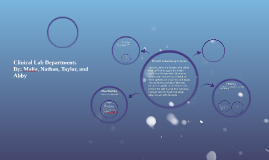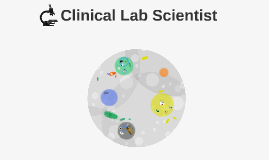Clinical Lab Departments
Transcript: abcess, anaerobic cultures, blood, bone marrow, catheter tips, tissue, and urine. Gloves, masks, and gowns. Must immediately disinfect area with 10% bleach or other approved disinfectant freshly drawn blood and fixed tissue diabetes, Gauncher disease, and Grave's Disease Blood tests are preformed. screening for blood group antibodies ABO group and RH type Diseases/conditions that can be diagnosed in this department Personal Protective Equipment Examples of Tests Performed Chemistry that is used for the analysis of bodily fluids Diseases and Conditions Clinical Laboratory Science, also called Medical Technology, is the health profession that provides laboratory information and services needed for the diagnosis and treatment of disease. They perform a variety of lab tests, ensure the quality of the tests results, explain the significance of of lab tests, evaluate new methods and study effectiveness with the tests. Clinical Laboratory Science Diseases Handling Precautions Tests performed Microbiology is the branch of science that deals with microorganisms. direct examination and techniques, culture, microbial identification, serodiagnosis, antimicrobial susceptability Specimen Examples Blood glucose levels, electrolytes, enzymes, and hormones Samples Clinical Lab Departments By: Malia, Nathan, Taylor, and Abby Common Specimens Blood and urine Microbiology Common Tests AIDS, HIV, Hepatitis Viruses, Cytomegalovirus, Human T-cell lymphotrophic virus, Parvovirus B19 Haemophilus influenza meningitis, Chlamydia trachomatis, Herpes symplex, Upper and Lower respiratory infections, and Streptococcus Blood Banking Chemistry Lab coats, gloves, safety glasses/goggles, face shields, shoe covers, and a MSDS.

















